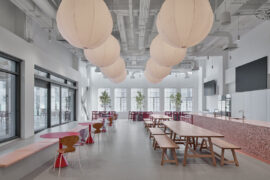This new building provides a thoughtful design intervention that allows Australia’s largest colony of Little Penguins to thrive.

December 4th, 2023
Every evening at sunset, a huddle of Little Penguins emerge from the waters surrounding Phillip Island, making their way up through the sandbanks to find their burrows. This is the nightly ritual of Australia’s largest colony of Little Penguins and represents the country’s number one natural wildlife attraction.
But like much of the world’s natural environment, this group of Penguins are threatened by climate change, making their preservation the highest priority for Phillip Island Nature Parks. So when it came time for a new visitor centre to be commissioned by the park, they set a brief for a space that would maintain the attraction of the penguin crossing without encroaching on the landscape and the habitats of the island’s star attractions.
The new visitor centre, an expansive, star-shaped structure by Australian and Danish studio TERROIR, is a thoughtful intervention that balances tourism and ecology through mindful architecture. Situated further back from the island’s waters than the previous centre, the new building has restored seven hectares of penguin habitat and has a string of environmental considerations to ensure the building is respectful of the island’s ecology.

“The roof now boasts an impressive array of 666 solar panels, a water filtration system recycling rainwater for non-potable use and double glazing and increased insulation in the roof and floor,” says Scott Balmforth, Director of TERROIR. “The building was also sited with ecological considerations so as to avoid areas where the penguins are likely to build burrows.”
While the performance and place of the centre were paramount to the project’s brief, TERROIR also deeply considered how the building’s aesthetics would help connect it to the surrounding environment. Sitting at the intersection of the beach, headland and wetlands, the tips of the polygonal exterior point to the different landscapes, with elements of each referenced in the materiality of the facade.
“The COLORBOND® Ultra-steel custom colour Cosmic® in a metallic finish, really suits the flourishing habitat reinstated by Philip Island Nature Parks. The roof picks up on the surrounding green, grey, silvery colours, and takes on those aspects of colour and light from the bushland, particularly late in the day when most people are arriving,” reflect Balmforth.
“The roof colour also visually connects with other parts of the building, such as the metal tiles around the edge and timber decking surface, placing all the materials in the same shimmering, silvery colour palette.”
More than simply playing off its visual surroundings, the visitor centre’s design is inspired by the resident penguins, with the light roof and darker underbelly an architectural ode to the coat of the Little Penguin.

As much as COLORBOND® made an aesthetic statement, it was also integral in creating a structure that had longevity at its core. The selection of Ultra-steel, designed for severe marine environments, ensures the building is able to withstand the sometimes hostile conditions of the Bass Strait. A roof of LYSAGHT KLIP-LOK 700 HI-STRENGTH® profile adds to the centre’s strength, with long runs and concealed fixings helping to minimise the number of penetrations required. This roofing system was also relatively simple and quick to assemble, which helped to expedite the construction schedule and ensure the project was completed before the penguin’s breeding season began.
“We canvassed a number of different roofing material options, but in the end COLORBOND® Ultra-steel in LYSAGHT KLIP-LOK 700 HI-STRENGTH® profile won out,” says Balmforth.
As with any building that sits in a carefully balanced ecosystem, the success of the new visitor centre will always be measured not just in how the building looks and performs, but importantly in how it interacts with its environment, and the effect it has on the colony of penguins who call Phillip Island home. And with Balmforth recounting a recent night where the penguin crossing saw almost 5000 creatures make the journey to land, the new Phillip Island Visitor Centre is looking like a job very well done.
To learn more about this project and watch the video on line click here.
INDESIGN is on instagram
Follow @indesignlive
A searchable and comprehensive guide for specifying leading products and their suppliers
Keep up to date with the latest and greatest from our industry BFF's!

At the Munarra Centre for Regional Excellence on Yorta Yorta Country in Victoria, ARM Architecture and Milliken use PrintWorks™ technology to translate First Nations narratives into a layered, community-led floorscape.

From the spark of an idea on the page to the launch of new pieces in a showroom is a journey every aspiring industrial and furnishing designer imagines making.

Sydney’s newest design concept store, HOW WE LIVE, explores the overlap between home and workplace – with a Surry Hills pop-up from Friday 28th November.

In an industry where design intent is often diluted by value management and procurement pressures, Klaro Industrial Design positions manufacturing as a creative ally – allowing commercial interior designers to deliver unique pieces aligned to the project’s original vision.

With the trio of buildings at One Sydney Harbour in full operation, our editor joined the visiting Renzo Piano Building Workshop team for a site visit.

A vacant plot in the heart of Wolli Creek in Bayside in South Sydney has been transformed by CONTEXT into a vibrant community park.

The 2024 Sustainability Awards Winners bestowed its honours on 18 winners, with 10 others receiving honourable mentions — a small gesture for contributions that loom large in our shared narrative of sustainability.

Nestled amidst the fern gullies and towering Mountain Ash rainforest of the Dandenong Ranges, the new Puffing Billy Railway Visitor Centre emerges as a striking, intentionally rugged structure honouring its geographical context and rich locomotive heritage.
The internet never sleeps! Here's the stuff you might have missed

The new headquarters for Omnicom in Melbourne’s CBD sees heritage re-invigorated with style and finesse.

Melbourne-based Studio Edwards has designed Shift+Space, a modular system under the banner of ‘adaptive retail architecture’. Ben Edwards tells us more.